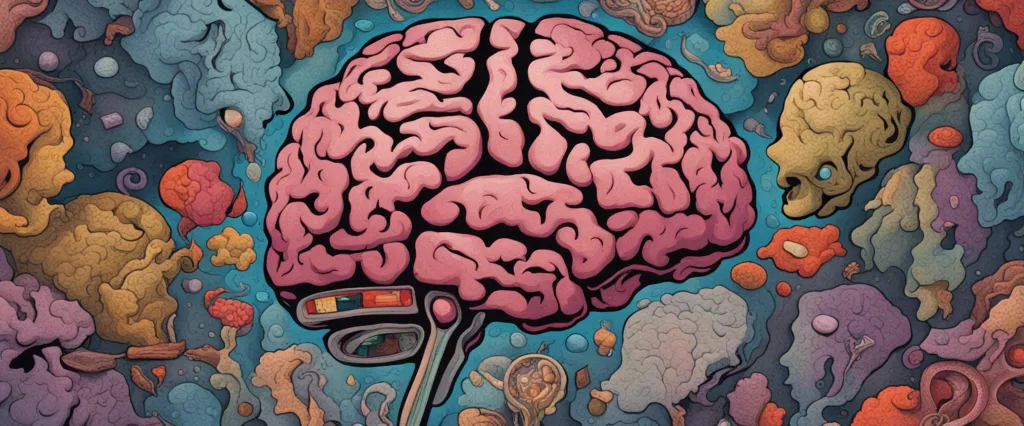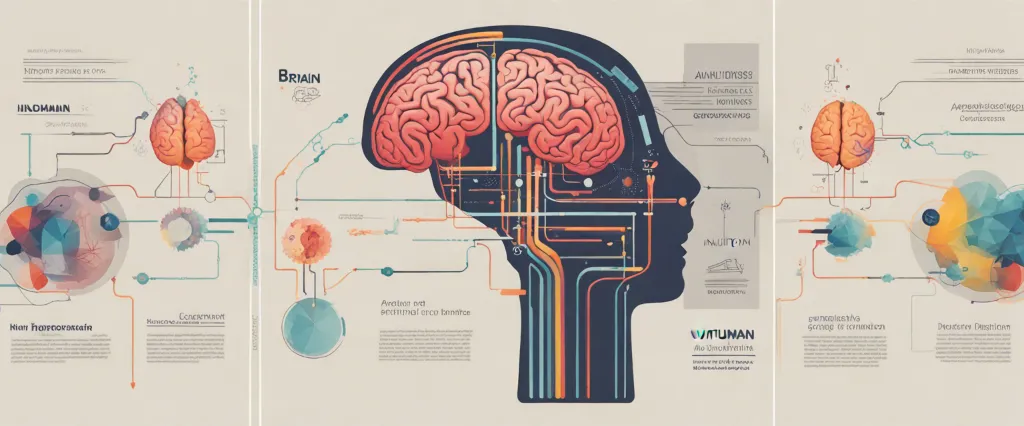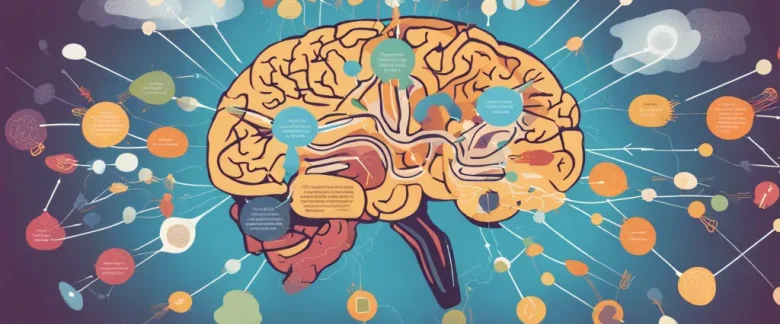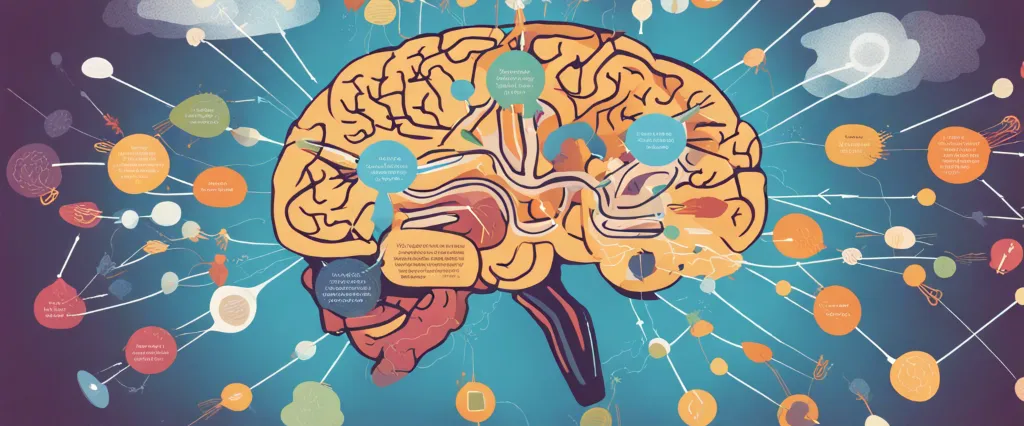In “The Brain,” celebrated neuroscientist David Eagleman delves into the fascinating and enigmatic world of the human brain. This comprehensive and engaging study explores the intricacies of our brain’s structure, function, and its role in shaping our perception of the world. Eagleman, a renowned neuroscientist, is not only the author of several best-selling books but also a television presenter and holder of multiple scientific patents. Through his work, he has gained immense recognition for his groundbreaking research and innovative approach towards unraveling the mysteries of the brain.
Chapter 1: The Brain’s Complexity – Introducing the intricate and complex nature of the brain.
Chapter 1 of “The Brain” by David Eagleman delves into the intricate and complex nature of the human brain, setting the stage for the exploration of its various functions and capabilities throughout the book.
Eagleman begins by emphasizing the incredible complexity of the brain, which consists of around 100 billion neurons with trillions of connections. He likens the brain to a city and neural networks to its roads, illustrating the immense scale and potential for information processing. With this metaphor, he highlights how the brain is constantly changing and adapting, constantly constructing and reconstructing itself.
The author then introduces the concept of plasticity, which refers to the brain’s ability to reorganize itself in response to new experiences or to recover from injury. He provides examples of individuals who have recovered and regained functionality after suffering severe brain damage, highlighting the brain’s resilience and capacity for adaptation.
Eagleman also explores the nature of consciousness, questioning whether free will truly exists or if our choices are predetermined by the brain’s subconscious processes. He argues that though we may feel like conscious decision-makers, much of our behavior is driven by unconscious neural processes, which have been shaped by genetics and prior experiences.
Overall, this introductory chapter offers a glimpse into the vast and intricate workings of the brain, challenging conventional notions of consciousness and highlighting the brain’s capacity for change and adaptation. It sets the stage for further exploration of the brain’s complexities, inviting readers to delve deeper into the mysteries of this remarkable organ.
Chapter 2: Sensory Perception – Exploring how the brain perceives and interprets sensory information.
Chapter 2 of “The Brain” by David Eagleman explores the intricate process through which the brain perceives and interprets sensory information. The chapter delves into the multifaceted nature of our sensory perception, highlighting the exquisite complexity of our brain’s ability to make sense of the world.
Eagleman begins by describing the various sensory modalities humans possess, which include vision, audition, touch, taste, and smell. He emphasizes that each of these modalities is not just a simple input, but rather a result of complex neural computations that occur in different areas of the brain. For instance, visual information is processed in the occipital lobe, while hearing is processed in the temporal lobes.
The author explains that our perception is not a direct reflection of reality, but rather a construction created by our brain. Our brain receives raw sensory data and processes it to form an intelligible and meaningful representation. Eagleman discusses experiments where sensory input is manipulated or distorted, revealing that our brain adapts and adjusts its interpretations accordingly.
Furthermore, Eagleman reveals the intriguing phenomenon of synesthesia, in which a person’s senses get intertwined, leading to experiences like tasting colors or seeing sounds. He suggests that synesthesia occurs because the brain’s neural networks responsible for processing sensory information become cross-wired.
The chapter also covers the influence of attention on perception, demonstrating that our brain selectively chooses which information to prioritize and process further.
In summary, Chapter 2 of “The Brain” delves into the complexities of sensory perception, highlighting how our brain constructs an understanding of the world around us. Eagleman illustrates how different sensory modalities are processed in specific brain regions, emphasizing that our perception is not a direct reflection of reality. The chapter also touches upon fascinating phenomena like synesthesia and the role of attention in shaping our perception.
Chapter 3: Time Perception – Examining how the brain constructs our perception of time.
In Chapter 3 of “The Brain” by David Eagleman, titled “Time Perception – Examining how the brain constructs our perception of time,” the author explores how our brains perceive and process the concept of time. Eagleman starts by highlighting the perplexing nature of time and introduces the idea that our experience of time is a construction of the brain.
The chapter delves into various aspects of time perception, including how our brains perceive time differently in different situations. Eagleman discusses experiments that reveal the brain’s ability to distort time and how it can be influenced by factors like emotional state and attention. For example, time can seem to slow down in intense or life-threatening situations, allowing individuals to react quickly.
Eagleman also delves into the relationship between memory and time perception. Our memories are not an accurate representation of the exact duration of events, as the brain can compress or expand these experiences when recalling them. He highlights that this distortion can affect our sense of time, making it feel like certain events were shorter or longer than they actually were.
Furthermore, Eagleman explores the concept of subjective time and the brain’s inherent ability to manipulate it. He explains how the brain constructs time by combining various sensory inputs and neural computations. The author also emphasizes the importance of the brain’s predictions and expectations in shaping our perception of time.
Overall, Chapter 3 in “The Brain” provides a thought-provoking exploration of how our brains construct and perceive time and offers insight into the processes that influence our everyday experiences of temporal duration.
Chapter 4: Neural Plasticity – Discussing the brain’s ability to adapt and rewire itself.

In Chapter 4 of “The Brain” by David Eagleman, the author explores the concept of neural plasticity, which refers to the brain’s remarkable ability to adapt and rewire itself. Eagleman begins by dispelling the long-held belief that the brain’s structure is rigid and fixed once it reaches adulthood. Instead, he emphasizes the brain’s dynamic nature, constantly changing and rewiring its intricate network of neurons.
The chapter delves into various aspects of neural plasticity, including the brain’s ability to reassign functions to different areas after injury. Eagleman provides captivating examples such as the case of a blind man whose brain rewires itself to process visual information using the auditory cortex. This phenomenon of cross-modal compensation showcases the remarkable adaptability of the brain.
Furthermore, the author elucidates how learning and experience play pivotal roles in shaping neural connections. He discusses the concept of synaptic pruning, where unused connections are pruned to make room for more efficient ones. This allows the brain to optimize its resources and refine its capabilities. Eagleman highlights groundbreaking research in the field, including studies on the rewiring of the brain in response to learning a new skill or during the recovery from a stroke.
Lastly, the chapter explores the potential applications of neural plasticity in various fields. Eagleman discusses how harnessing plasticity can lead to groundbreaking advancements in neurorehabilitation and cognitive enhancement. He also raises ethical concerns regarding the manipulation of neural plasticity and emphasizes the importance of understanding the brain’s adaptability to leverage this knowledge responsibly.
In conclusion, Chapter 4 of “The Brain” delves into the concept of neural plasticity, showcasing the brain’s remarkable ability to adapt, rewire, and optimize its structure and function. It highlights the significance of learning, experience, and recovery from injury in reshaping neural connections and emphasizes the potential societal implications and ethical considerations surrounding this fascinating aspect of neuroscience.
Chapter 5: Decision-Making – Investigating the processes and factors that influence our decision-making.
Chapter 5 of “The Brain” by David Eagleman focuses on investigating the processes and factors that influence decision-making. Eagleman delves into the complex mechanisms that drive our choices and explores the interplay between conscious and unconscious processes in decision-making.
The chapter begins by emphasizing the importance of decision-making and its pervasive influence in our lives. Eagleman explains that decision-making is not a single process but rather a series of computational steps occurring within the brain. These computations involve collecting, weighing, and prioritizing information to arrive at a decision.
Eagleman highlights the role of the prefrontal cortex in decision-making, a region responsible for executive functions such as planning, self-control, and rational decision-making. He emphasizes that the prefrontal cortex operates in conjunction with other brain regions, including those involved in emotions, memories, and sensory information, to make decisions that are both logical and emotionally satisfying.
The author explores the concept of neural networks and their formation throughout our lives. These networks shape our decision-making by accumulating past experiences, biases, and cultural influences. Eagleman argues that our choices are not purely rational, as we are heavily influenced by unconscious factors and biases.
Additionally, the chapter discusses the impact of emotions on decision-making. Eagleman explains that emotions often guide our choices, suggesting that our gut instincts play a crucial role in the decision-making process. He also explores the connections between decision-making and reward circuits in the brain, highlighting how external stimuli and desires can affect our choices.
Overall, Chapter 5 of “The Brain” provides a comprehensive overview of decision-making processes and the various factors that influence them. Eagleman emphasizes the multidimensional nature of decision-making, incorporating both conscious and unconscious elements, emotions, and neural networks to shed light on the complexity of our choices.
Chapter 6: Consciousness – Exploring the mysteries of consciousness and self-awareness.
In Chapter 6 of “The Brain” by David Eagleman titled “Consciousness – Exploring the Mysteries of Consciousness and Self-Awareness,” the author delves into the enigmatic nature of consciousness and investigates how it arises from the brain.
Eagleman begins by highlighting the complexity of consciousness, referring to it as the “crown jewel” of the brain. He emphasizes that despite decades of research, understanding consciousness remains one of science’s greatest challenges. The chapter highlights fascinating studies that explore the concept of self-awareness, such as behavioral tests with mirror self-recognition in monkeys.
Next, the chapter delves into the various theories of consciousness. Eagleman explores the traditional view of consciousness as a serial stream of thoughts and perceptions, but he also questions this perspective. He introduces alternative theories, such as the idea that consciousness arises from integrated neural activity across multiple brain regions. Additionally, he discusses how our conscious experience might be influenced by factors such as attention and memory.
Furthermore, the author explores the conditions under which consciousness can be altered, referencing anesthesia and sleep as states that disrupt normal conscious experience. He also ponders the phenomenon of near-death experiences and the potential insights they might offer into the nature of consciousness.
The chapter emphasizes the significance of investigating consciousness, as it shapes our understanding of the self and our place in the world. Eagleman concludes by reiterating the importance of unraveling the mystery of consciousness and the potential impact it could have on fields such as artificial intelligence and neuroscience.
Chapter 7: Mental Illness – Highlighting the connection between brain abnormalities and mental disorders.
Chapter 7 of the book “The Brain” by David Eagleman explores the connection between brain abnormalities and mental disorders, focusing on how the brain’s physical structure impacts mental health. Eagleman emphasizes that mental illnesses are not purely psychological or moral failings, but rather result from specific alterations and dysfunctions within the brain.
The chapter begins by discussing the different types of mental illnesses, such as schizophrenia and depression, which affect millions of people worldwide. Eagleman stresses that these conditions are neurobiological disorders, rooted in abnormalities or imbalances in brain structures and functions. Through decades of research and advanced imaging techniques, scientists have identified specific brain regions that are associated with various mental disorders.
Eagleman explores the intricate network of connections within the brain and explains how disruptions in these pathways can contribute to mental illness. He describes the role of neurotransmitters, the chemical messengers responsible for communication between brain cells, and how imbalances in these chemicals can result in mental health conditions.
The chapter also delves into the genetic and environmental factors that influence the development of mental illnesses. Eagleman explains that while genetics play a significant role, environmental factors, including childhood experiences and trauma, can also shape the brain’s structure and function, increasing the risk of mental disorders.
Importantly, Eagleman emphasizes that understanding the brain’s role in mental illness is essential for reducing stigma and promoting empathy towards those who suffer from these conditions. He advocates for a comprehensive approach that combines medication, therapy, and a supportive environment to address mental health issues effectively.
In conclusion, Chapter 7 of “The Brain” highlights the connection between brain abnormalities and mental disorders, emphasizing that mental illnesses are not solely a result of personal shortcomings but rather complex neurological conditions. By unraveling the neural underpinnings of these disorders, scientists can improve diagnosis, treatment, and societal understanding of mental health.

Chapter 8: Future Possibilities – Speculating on the potential advancements and implications of brain research.
Chapter 8 of “The Brain” by David Eagleman, titled “Future Possibilities – Speculating on the potential advancements and implications of brain research,” delves into the exciting and thought-provoking prospects that lie ahead in the field of neuroscience. Eagleman explores various paths that brain research could take, highlighting the potential advancements and their implications.
One avenue he discusses is the potential for enhancing the capabilities of the human brain. Eagleman explores the possibility of improving memory, intelligence, and sensory perception through technological interventions. He envisions a future where brain-machine interfaces allow individuals to connect their minds directly to external devices, expanding their cognitive abilities and granting access to vast amounts of information instantly.
Another area of exploration is the understanding of consciousness. Eagleman poses questions about whether it could be artificially simulated or transferred, leading to significant ethical and philosophical implications. He touches upon the concept of mind uploading, where one’s consciousness can potentially be transferred to a digital format, allowing for immortality or multi-bodied experiences.
Eagleman also speculates on the potential applications of brain research in criminal justice, including the ability to detect and manipulate memories, leading to potential advancements in rehabilitation techniques and the understanding of criminal behavior.
Ultimately, the chapter offers a glimpse into the future possibilities of neuroscientific research, emphasizing both the excitement and ethical concerns that such advancements may bring. Eagleman encourages continued exploration and collaboration within the field to ensure responsible progress and the maximization of the benefits of brain research for society as a whole.
After Reading
In conclusion, David Eagleman’s book “The Brain” offers a captivating and insightful journey into the inner workings of our most complex organ. Through a combination of scientific research, real-life examples, and thought-provoking anecdotes, Eagleman presents a comprehensive understanding of the brain’s capabilities, limitations, and potential. From exploring the mysteries of perception to delving into the intricacies of memory, consciousness, and decision-making, the book sheds light on how our brains shape our experiences and ultimately define our very existence. With its engaging storytelling and accessible style, “The Brain” serves as a valuable resource for anyone curious about unlocking the secrets of the mind and the wonders of human cognition.
1. “The Tell-Tale Brain: A Neuroscientist’s Quest for What Makes Us Human” by V.S. Ramachandran – In this captivating and approachable book, Ramachandran explores the mysteries of the human brain through real case studies and provides fascinating insights into how our brain shapes our experiences and defines who we are.
2. “Incognito: The Secret Lives of the Brain” by David Eagleman – Although not the same book by David Eagleman mentioned, “Incognito” is another extraordinary work by the author that offers an engaging exploration of the unconscious processes that govern our thoughts, decisions, and behaviors. Eagleman delves into the hidden workings of our brain with his characteristic wit and insight.
3. “The Man Who Mistook His Wife for a Hat” by Oliver Sacks – Renowned neurologist Oliver Sacks tells the captivating stories of some of his patients in this collection. Through these cases, Sacks highlights the extraordinary adaptability of the human brain, even in the face of devastating neurological disorders, and offers readers a glimpse into the mysteries and wonders of our mind.
4. “Phantoms in the Brain: Probing the Mysteries of the Human Mind” by V.S. Ramachandran and Sandra Blakeslee – In this collaboration, Ramachandran and Blakeslee provide a captivating exploration of perceptual illusions and strange neurological conditions. Through examples, they probe the intricacies of our brain and how it creates our reality, setting the stage for a remarkable journey into the human mind.
5. The Brain that Changes Itself: Stories of Personal Triumph from the Frontiers of Brain Science” by Norman Doidge – Doidge’s book is a fascinating exploration of neuroplasticity, the brain’s ability to rewire and adapt. Through inspiring stories of patients who have overcome debilitating conditions, Doidge showcases the incredible potential of our brains to change and heal, opening up new possibilities for rehabilitation and understanding.




